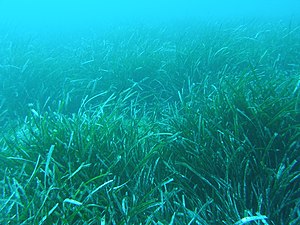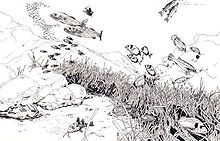Neptune grass
| Neptune grass | ||||||||||||
|---|---|---|---|---|---|---|---|---|---|---|---|---|

Mediterranean neptune grass ( Posidonia oceanica ) |
||||||||||||
| Systematics | ||||||||||||
|
||||||||||||
| Scientific name of the family | ||||||||||||
| Posidoniaceae | ||||||||||||
| Vines | ||||||||||||
| Scientific name of the genus | ||||||||||||
| Posidonia | ||||||||||||
| KDEKoenig |
Neptune grasses ( Posidonia ), also called Neptune plants, are the only genus of the Neptune grass family (Posidoniaceae) in the order of the frog-spoon-like (Alismatales) within the monocot plants . It is one of the genera whose species, like many species of the order Frog-Spoon-like, with a similar habitus and habitat, are called "seaweed". They thrive in flat temperate to subtropical sea areas of the Mediterranean and west to south of Australia .
description


Habit and leaves
Posidonia species grow as grass-like, perennial , herbaceous plants . These marine, submerged aquatic plants are anchored to the sea floor with monopodial rhizomes . All parts of the plant are hairless.
The alternate and two-line leaves are divided into leaf sheath and leaf blade and have no petiole. The leaf sheath is open. The simple and flat to petiolate leaf blade has one nerve or several parallel nerves without side nerves. The leaf margins are smooth or serrated. There are no stomata . There are scales in the leaf axils.
Inflorescences and flowers
There are leafless inflorescence stems. The differently structured inflorescences are composed of spike-like, little-flowered partial inflorescences and have no bracts.
The tiny, hermaphrodite flowers are reduced. There are no bracts . There is a circle with three free, fertile stamens ; since no stamens are formed, they have sedentary anthers. The thread-like pollen grains have no aperture and are released into the sea. There is only one upper carpel in each flower . Each carpel contains only one pendulous, orthotropic ovule . There is no stylus, so the irregularly lobed stigma sits directly on the ovary. The pollination is carried out in the water.
Fruits and seeds
They form buoyant, more or less fleshy follicles through air chambers in the pericarp . The seeds contain a straight embryo and no endosperm . When the pericarp dissolves, the seed sinks to the bottom of the sea and immediately begins to germinate.
Ingredients and chromosomes
There are proanthocyanidins present. The basic chromosome number is x = 10.
Ecology and locations
Posidonia species, like the other seagrass species, are the basis for their own ecosystems . Posidonia species thrive in shallow, temperate to subtropical sea areas.
Systematics and distribution
The genus Posidonia was 1806 Charles King erected . Synonyms for Posidonia K.D.Koenig nom. cons. are: Posidonion St.-Lag. orth. var., Caulinia DC. nom. illeg., Kernera Willd. nom. illegal, Alga Boehm. , Taenidium Targ.Tozz. , Aegle Dulac .
The surname Posidoniaceae was published by Sydney Howard Vines in 1895 ; other publications are also often cited, for example by John Hutchinson in Fam. Fl. II, monocot. , 1934, 41 or (Kunth) Lotsy . Within the order of the Alismatales , the Posidoniaceae are most closely related to the Ruppiaceae and Cymodoceaceae .
There are nine species in the genus Posidonia . Only Posidonia oceanica occurs in the Mediterranean , all other species are distributed west to south of Australia . The Australian species were divided into two groups.
- The following is common in the Mediterranean and on the south-western European Atlantic coast:
- Posidonia oceanica (L.) Delile
- In the sea south and west of Australia occur:
-
Posidonia australis group:
- Posidonia angustifolia Cambridge & Kuo
- Posidonia australis Hook. f.
- Posidonia sinuosa Cambridge & Kuo
-
Posidonia ostenfeldii group:
- Posidonia coriacea Cambridge & Kuo
- Posidonia denhartogii Kuo & Cambridge
- Posidonia kirkmanii Kuo & Cambridge
- Posidonia ostenfeldii den Hartog
- Posidonia robertsoniae Kuo & Cambridge
-
Posidonia australis group:
Posidonia robertsoniae and Posidonia coriacea may not be genetically different, so they are just a single species.
All eight Australian Posidonia species occur off Western Australia . Posidonia angustifolia , Posidonia coriacea , Posidonia denhartogii and Posidonia sinuosa are also found off South Australia and Posidonia australis is most widespread in New South Wales , South Australia, Western Australia, Victoria and Tasmania .
swell
- The family of Posidoniaceae in APWebsite. (Sections systematics and description)
- The Posidoniaceae family at DELTA by L. Watson & MJ Dallwitz. (Section description)
- Youhao Guo, Robert R. Haynes, C. Barre Hellquist: Posidoniaceae. In: Wu Zheng-yi, Peter H. Raven, Deyuan Hong (Eds.): Flora of China . Volume 23: Acoraceae through Cyperaceae . Science Press / Missouri Botanical Garden Press, Beijing / St. Louis 2010, ISBN 978-1-930723-99-3 , pp. 117 (English). , online , PDF file (sections description, classification and distribution).
- Mike van Keulen: The genus Posidonia König (nom. Cons.) (Posidoniaceae). Murdoch University, online (Systematics and Description sections).
- Leslie Watson: Posidoniaceae. In: Western Australian Herbarium (Ed.): FloraBase. The Western Australian Flora. Department of Environment and Conservation 2008, online.
- C. den Hartog, John Kuo: Posidoniaceae. In: AWD Larkum, Robert Joseph Orth, Carlos M. Duarte: Seagrasses: Biology, Ecology, and Conservation. Springer, Dordrecht 2006, ISBN 1-402-02942-X , pp. 10–11, limited preview in the Google book search (sections systematics and description).
Individual evidence
- ^ Karl Dietrich Eberhard König : Addition to M, Cavolini's Treatise on Zostera oceanica L. In: Annals of Botany (König & Sims). Volume 2, No. 1, 1805, p. 95, PDF file.
- ↑ a b c Rafaël Govaerts (Ed.): Posidonia. In: World Checklist of Selected Plant Families (WCSP) - The Board of Trustees of the Royal Botanic Gardens, Kew . Retrieved August 21, 2014.
- ^ Sydney Howard Vines: A student's text-book of botany. Macmillan, London 1895, p. 553, digitized .
- ↑ John Kuo, AJ McComb In: AWD Larkum, AJ McComb, SA Shepherd (Eds.): Biology of Seagrasses. A treatise on the biology of seagrasses with special reference to the Australian region (= Aquatic Plant Studies 2). Elsevier, Amsterdam 1989, ISBN 0-444-87403-8 , pp. 6-73.
- ↑ James Edward Dandy : Posidonia C. King . In: TG Tutin, VH Heywood, NA Burges, DM Moore, DH Valentine, SM Walters, DA Webb (eds.): Flora Europaea . Volume 5: Alismataceae to Orchidaceae (Monocotyledones) . Cambridge University Press, Cambridge 1980, ISBN 0-521-20108-X , pp. 12 (English, limited preview in Google Book Search).
Web links
- Rehabilitation of Posidonia oceanica seagrass meadows.
- On the ecology of Posidonia oceanica . ( Memento of October 7, 2007 in the Internet Archive )


